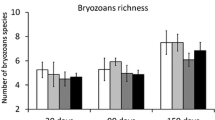Summary
The subtidal communities of sessile organisms on the pilings of two piers were observed by photography of fixed quadrats over a period of two years. Data are presented on species-composition, relative abundance of species, and maximum longevities of individuals and colonies. The fluctuations in various properties of the communities (e.g. measures of species diversity, and percentage vovers of species and phyletic groups) are tested by a priori defined criteria for “narrow stochastic boundedness” and most are found to be narrowly bounded, despite considerable turnover of space. We conclude that most properties of the community vary less through time-that is, the community is in a sense more “stable”-than fouling communities previously studied using small plates immersed for relatively short periods. Long-lived species are relatively more abundant on the pilings than in plate-studies. These differences are attributed to the large size and long period of submersion of the pilings. Our results appear similar to those of other studies on large, old substrata.
Similar content being viewed by others
References
Anger K (1978) Development of a subtidal epifaunal community at the Island of Helgoland. helgolander wiss Meeresunters 31:457–470
Chesson PL (1978) Predator-prey theory and variability. Ann Rev Ecol Syst 9:323–347
Dayton PK (1971) Competition, disturbance and community organization: the provision and subsequent utilization of space in a rocky intertidal community. Ecol Monogr 41:351–389
Elton CS (1958) The ecology of invasions by animals and plants. Methuen, London
Fisher RA, Corbett AS, Williams CB (1943) The relation between the number of species and the number of individuals in a random sample of an animal population. J Anim Ecol 12:42–58
Frank PW (1968) Life histories and community stability. Ecology 49:355–357
Goodman D (1975) The theory of diversity-stability relationships in ecology. Q Rev Biol 50 (3):237–266
Harper JL, Bell AD (1979) The population dynamics of growth form in organisms with modular construction. In: RM Anderson, BD Turner, and LR Taylor (eds) Population Dynamics. 20th Symp British Ecol Soc Blackwell, Oxford, p. 29–52
Harris J (1978) The ecology of marine epifaunal communities on the pilings of Portsea pier, Victoria. Honours Thesis, Dept. Zoology, University of Melbourne
Holling CS (1973) Resilience and stability of ecological systems. Ann Rev Ecol Syst 4:1–23
Jackson JBC (1977) Habitat area, colonization and development of epidenthic community structure. In: BF Keegan, PO' Ceidigh, PJS Boaden (eds) Biology of benthic organisms, Proc 11th Eur Symp Mar Biol. Pergamon Press, Oxford, p. 349–358
Karlson R (1978) Predation and space utilization patterns in a marine epifaunal community. J exp mar Biol Ecol 31:225–239
Kay AM (1980) The Organization of Sessile Guilds on Pier Pilings. Ph.D. Thesis, Dept. Zoology, University of Adelaide
Kay AM, Keough MJ (1981) Occupation of patches in the epifaunal communities on pier pilings and the bivalve Pinna bicolor at Edithburgh, South Australia. Oecologia (Berl) 48:123–130
Keough MJ (1981) Community dynamics of the epifauna of the bivalve Pinna bicolor Gmelin. PhD Thesis, Dept Zology, University of Adelaide
Keough MJ, Butler AJ. Temporal changes in species number in an assemblage of sessile marine invertebrates. In preparation
MacArthur RH (1955) Fluctuations of animal populations, and a measure of community stability. Ecology 36:533–536
Margalef R (1969) Diversity and stability: A practical proposal and a model of interdependence. Brookhaven Symp. Biol. 22:25–37
May RM (1975) Stability in ecosystems: some comments. In: WH van Dobben and RH Lowe-McConnell (eds) Unifying Concepts in Ecology. Junk, The Hague; Pudoc, Wageningen, p. 161–168
Orians GH (1975) Diversity, stability and maturity in natural ecosystems. In: WH van Dobben and RH Lowe-McConnell (eds) Unifying Concepts in Ecology, Junk, The Hague; Pudoc, Wageningen, p 139–150
Osman RW (1977) The establishment and development of a marine epifaunal community. Ecology Monogr 47:37–63
Pielou EC (1966) The measurement of diversity in different types of biological collections. J Theor Biol 13:131–144
Pielou EC (1975) Ecological Diversity. Wiley, N.Y.
Russ GR (1980) Effects of predation by fishes, competition, and structural complexity of the substratum on the establishment of a marine epifaunal community. J exp mar Biol Ecol 42:55–69
Russ GR (1981) Patterns of establishment and subsequent change in the structure of a marine epifaunal community. PhD Thesis, Dept Zoology, University of Melbourne
Sokal RR, Rohlf FJ (1969) Biometry. The principles and practice of statistics in biological research. Freeman, San Francisco
Sutherland JP (1974) Multiple stable points in natural communities. Am Nat 108:859–872
Sutherland JP (1975) Effect of Schizoporella (Ectoprocta) removal on the fouling community at Beaufort, North Carolina, U.S.A. In: BC Coull (ed) Ecology of Marine Benthos. University of Carolina Press, p 155–176
Sutherland JP (1976) Life histories and the dynamics of fouling communities. In: John D Costlow, Jr. (ed) Ecology of marine fouling communities, US-USSR Workshop within joint program “Biological Productivity and Biochemistry of the World's Oceans”, U.S. Naval Institute Press, Annapolis, Md, p 137–153
Sutherland JP (1978) Functional roles of Schizoporella and Styela in the fouling community at Beaufort. Ecology 59:257–264
Sutherland JP (1981) The fouling community at Beaufort, North Carolina: a study in stability. Am Nat 118:499–519
Sutherland JP, Karlson RH (1973) Succession and seasonal progression in the fouling community at Beaufort, North Carolina. Proc. 3rd Int. Congr. Mar. Corrosion and Fouling. Northwestern University Press, Evanston, Illinois, p 906–929
Sutherland JP, Karlson RH (1977) Development and stability of the fouling community at Beaufort, North Carolina. Ecol Monogr 47:425–446
Whittaker RH (1965) Dominance and diversity in land plant communities. Science 147:250–260
Whittaker RH (1975) The design and stability of plant communities. In: WH van Dobben and RH Lowe-McConnell (eds) Unifying concepts in ecology. Junk, The Hague; Pudoc, Wageningen, p 169–181
Author information
Authors and Affiliations
Rights and permissions
About this article
Cite this article
Kay, A.M., Butler, A.J. ‘Stability’ of the fouling communities on the pilings of two piers in South Australia. Oecologia 56, 70–78 (1983). https://doi.org/10.1007/BF00378219
Received:
Issue Date:
DOI: https://doi.org/10.1007/BF00378219




